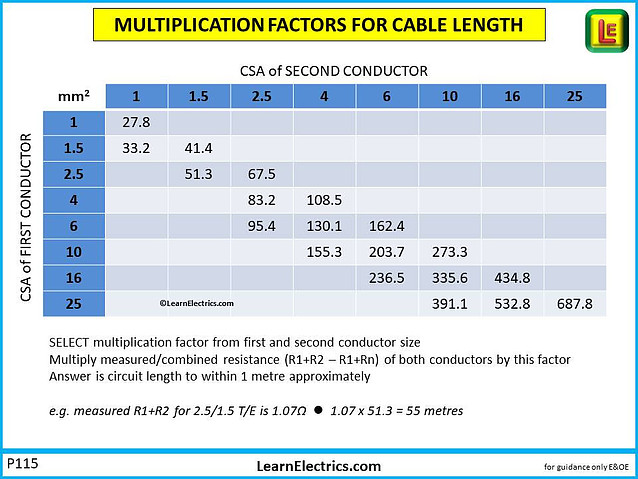CABLE LENGTH CALCULATIONS FROM RESISTANCE
When inspecting an installation, planning extensions to circuits and other remedial work, we may need to know the length of a circuit’s cables. You may know, for instance, that you have the two ends of a ring circuit, but do you know the route taken by the circuit’s twin and earth cables? Is it a short ring, just around the kitchen for instance, or is it a long circuit that winds itself from room to room.
Knowing a cables length can help enormously in the preliminary tracing of circuits. It will help you to decide if you need to be looking in more than one place for additional sockets or lighting points. And knowing the length can also tell you that a certain cable could not possibly reach that furthest point, that electrical outlet in the shed, for instance, must be served by another cable.

To use the table above, let us suppose that we have decided to test R1+R2, the Phase and Earth conductors of a 2.5mm2/1.5mm2
domestic twin and earth cable.
Join the Phase and Earth at one end using a connector block, crocodile clips or similar, making sure it is a good electrical joint. Badly connected conductors will give false readings.
Measure the resistance at the other end of the cable using the low ohms range of your test meter.
You now have an R1+R2 reading for this cable.
Now consult the chart above. We have included the popular sizes of twin and earth cables, but this also works for single cables, multicore cables etc.
Find the CSA or cross-sectional-area of the first cable (2.5mm2
Phase say) and follow this row in the table until it crosses the CSA of the second conductor (the 1.5mm2 Earth)
The number where the column and row crossover is the multiplication factor that should be multiplied by the R1+R2 ohms reading that you have just obtained.
In our example case we have measured the R1+R2 to be 1.07 ohms
And the multiplication factor for 2.5/1.5 from the table is 51.3
1.07 X 51.3 = 54.89
This can be rounded up to 55 metres.
Our circuit length will be approximately 55 metres.
___________________________________________________________
To download a printable PDF of the above table, click on the link below
P115 – CABLE LENGTH CALCULATIONS – printable PDF
___________________________________________________________
